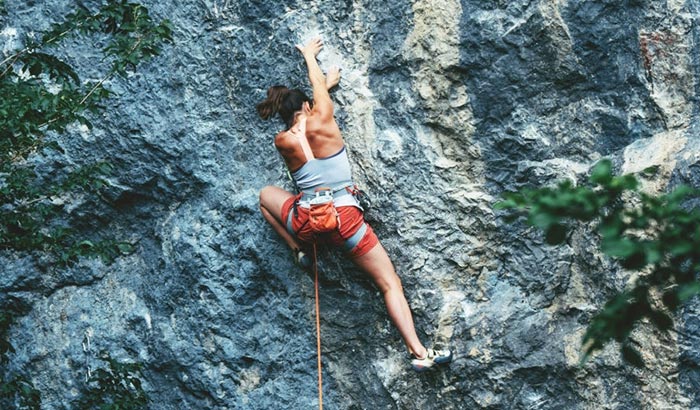If you are still new to a climbing discipline, it is essential for you to know the difference between lead climbing vs top rope. These two are climbing methods of protecting climbers from falling during the climb. They will both make you safe, but one is easier to do compared to the others.
The difference between top roping and lead climbing is all about the type of support given to the climber. When you do top-roping, you are supported from above to prevent you from falling. Lead climbing will need you to clip the protection as you go up to your destination.
Top Rope or Lead Climbing: Which is for you?
Top rope is a climbing method where a rope is fixed above at the destination of your climb. This rope will be folded in half at the anchor, while the belayer will be responsible for adjusting the length of the rope as the climber starts to climb.
In top-roping, the climber already has the rope that gives him security wherever he falls with the help of the belayer. If a climber loses balance, it is still safe because all that happens is the rope will only stretch less than a foot which will only cause minor scratches on your knees.
When you do top rope, you as the climber, and your belayer starts at the base of the climb. Meanwhile, the rope is still anchored at the top, which is your destination is similar to a climbing wall.
Most of the climbers I know of usually learn top-roping when they are still new and just starting to climb. It is easier and safer and will give you easy projections as you climb. You will also have the ability to position yourself easily because the anchor is already set up.
The rope is not set up from above for lead climbing because it goes directly to the climber from the belayer. When a climber reaches a particular bolt, he will clip a quickdraw into the bolt and take the rope while pulling it over the quickdraw.
As stated above, in lead climbing, the climber will set the anchor along the way until he reaches the destination above. These anchors are bolts that are bolts created or left in the wall. Meanwhile, the belayer will adjust the rope as the climber starts climbing, but the purpose is only to unroll it.
In lead climbing, once you fall, your fall is twice the distance between you and the last piece of protection you out on the wall. You then add the rope stretch, approximately add two feet in this situation. So, it is a must for you to plan well because it can be risky.
Most of the climbers doing lead climbing were using first the top rope method. Once their skills and confidence grow over time, these climbers tend to upgrade and choose the more difficult lead climbing method.
What is the Difference Between Top Roping and Lead Climbing?
Lead climbing is a lot tougher compared to top roping, making some climbers avoiding to do it. It is scarier, and the risk factor is bigger. However, as they say in life, the more difficult it is to do, the more is fun and fulfilling.
But for you to make the difference, there are factors that you need to know to distinguish between the two climbing methods. Please read below.
Level of Difficulty
As I mentioned a few times in this article, lead climbing is way harder compared to top-roping. Lead climbing will need you to make additional moves as you go up because you will need to set the anchors before moving forward.
Lead climbing also requires more mental concentration because if you make a mistake, the chance of an injury is bigger. The mental challenge itself can also affect the climber as he goes upward, making lead climbing more challenging to execute.
Level of Risk
As I have hinted in the early part of the article, lead climbing has a greater risk involved compared to the top rope. I can say that when you fall on the top rope, you can be caught immediately, provided that your belayers are quick to respond and very alert.
In lead climbing, it can be riskier since the climber may fall twice the distance between themselves and the last protection they clipped into. You can also add the possible stretch of the rope to make it riskier.
Also, the top rope method is usually used by people who are just starting to learn how to climb. The reason behind it is the anchor already set up on top makes it a lot safer when compared to lead climbing.
The Belay Difference
The belayer plays an important role when doing lead climbing or top-roping, but they have completely different functions between the two. When belaying in top rope, it is much easier and can be easily learned.
In the top rope method, the rope will be folded in half at the anchor. The function of the belayer is to adjust the length of the rope as the climber goes untoward towards the destination.
Lead climbing is a lot harder and requires the belayer to be more active all the time. The belayers should also be more skilled and experienced and pay close attention to the climber for any possible accident.
Since the climber will set the anchor along the way, the belayer will adjust the length of the rope as the climber goes up. But his function is mainly to unroll the rope as the climber goes up to the top.
Type of Application
If your climbing skills is limited to the top rope, your choice of location will also be limited. Indoor gyms and outdoor crags will be your possible climbing destinations. Meanwhile, when you are doing lead climbing, you will have several options as it opens more climbing disciplines such as trad, alpinism, ice climbing, and the like.
Conclusion
Knowing the difference between lead climbing vs top rope will make you realize your purpose in doing different climbing activities. If you are not afraid of doing lead climbing, then good for you. It will open more opportunities for you to do other extreme climbing disciplines but make sure to know the type of risk you are putting yourself into.


